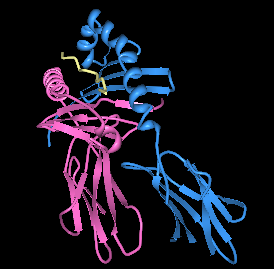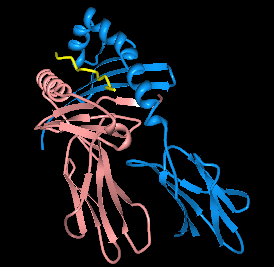
The human leukocyte antigen (HLA) system or complex is a group of related proteins that are encoded by the major histocompatibility complex (MHC) gene complex in humans. These cell-surface proteins are responsible for the regulation of the immune system. The HLA gene complex resides on a 3 Mbp stretch within chromosome 6p21. HLA genes are highly polymorphic, which means that they have many different alleles, allowing them to fine-tune the adaptive immune system. The proteins encoded by certain genes are also known as antigens, as a result of their historic discovery as factors in organ transplants. Different classes have different functions:

HLA class II histocompatibility antigen, DRB1 beta chain is a protein that in humans is encoded by the HLA-DRB1 gene. DRB1 encodes the most prevalent beta subunit of HLA-DR. DRB1 alleles, especially those encoding amino acid sequence changes at positions 11 and 13, are associated risk of rheumatoid arthritis.

HLA-DQ8 (DQ8) is a human leukocyte antigen serotype within the HLA-DQ (DQ) serotype group. DQ8 is a split antigen of the DQ3 broad antigen. DQ8 is determined by the antibody recognition of β8 and this generally detects the gene product of DQB1*0302.

HLA-DQ2 (DQ2) is a serotype group within HLA-DQ (DQ) serotyping system. The serotype is determined by the antibody recognition of β2 subset of DQ β-chains. The β-chain of DQ is encoded by HLA-DQB1 locus and DQ2 are encoded by the HLA-DQB1*02 allele group. This group currently contains two common alleles, DQB1*0201 and DQB1*0202. HLA-DQ2 and HLA-DQB1*02 are almost synonymous in meaning. DQ2 β-chains combine with α-chains, encoded by genetically linked HLA-DQA1 alleles, to form the cis-haplotype isoforms. These isoforms, nicknamed DQ2.2 and DQ2.5, are also encoded by the DQA1*0201 and DQA1*0501 genes, respectively.

HLA-DQ4 (DQ4) is a serotype subgroup within HLA-DQ(DQ) serotypes. The serotype is determined by the antibody recognition of β4 subset of DQ β-chains. The β-chain of DQ is encoded by HLA-DQB1 locus and DQ4 are encoded by the HLA-DQB1*04 allele group. This group currently contains 2 common alleles, DQB1*0401 and DQB1*0402. HLA-DQ4 and HLA-DQB1*04 are almost synonymous in meaning. DQ4 β-chains combine with α-chains, encoded by genetically linked HLA-DQA1 alleles, to form the cis-haplotype isoforms. These isoforms, nicknamed DQ4.3 and DQ4.4, are also encoded by the DQA1*0303 and DQA1*0401 genes, respectively.

HLA-DQ6 (DQ6) is a human leukocyte antigen serotype within HLA-DQ (DQ) serotype group. The serotype is determined by the antibody recognition of β6 subset of DQ β-chains. The β-chain of DQ isoforms are encoded by HLA-DQB1 locus and DQ6 are encoded by the HLA-DQB1*06 allele group. This group currently contains many common alleles, DQB1*0602 is the most common. HLA-DQ6 and DQB1*06 are almost synonymous in meaning. DQ6 β-chains combine with α-chains, encoded by genetically linked HLA-DQA1 alleles, to form the cis-haplotype isoforms. For DQ6, however, cis-isoform pairing only occurs with DQ1 α-chains. There are many haplotypes of DQ6.

HLA-DQ9 (DQ9) is a human leukocyte antigen serotype within the HLA-DQ (DQ) serotype group. DQ9 is a split antigen of the DQ3 broad antigen. DQ9 is determined by the antibody recognition of β9 and this generally detects the gene product of DQB1*0303.

HLA-DQ1 is a serotype that covers a broad range of HLA-DQ haplotypes. Historically it was identified as a DR-like alpha chain called DC1; later, it was among 3 types DQw1, DQw2 and DQw3. Of these three serotyping specificities only DQw1 recognized DQ alpha chain. The serotype is positive in individuals who bear the DQA1*01 alleles. The most frequently found within this group are: DQA1*0101, *0102, *0103, and *0104. In the illustration on the right, DQ1 serotyping antibodies recognizes the DQ α (magenta), where antibodies to DQA1* gene products bind variable regions close to the peptide binding pocket.

HLA-DR53 is an HLA-DR serotype that recognizes gene products of HLA-DRB4 locus. There are 13 alleles at this locus that encode 7 proteins.

HLA-DR16(DR16) is a HLA-DR serotype that recognizes the DRB1*1601, *1602 and *1604 gene products. DR16 is found in the Mediterranean at modest frequencies. DR16 is part of the older HLA-DR2 serotype group which also contains the similar HLA-DR15 antigens.

HLA-DR15 (DR15) is a HLA-DR serotype that recognizes the DRB1*1501 to *1505 and *1507 gene products. DR15 is found at high levels from Ireland to Central Asia. DR15 is part of the older HLA-DR2 serotype group which also contains the similar HLA-DR16 antigens.

HLA-DR14(DR14) is a HLA-DR serotype that recognizes the DRB1*1401 to *1408, *1410 to *1418, and other *14 gene products. DR14 serotype is a split antigen of the older HLA-DR6 serotype group which also contains the similar HLA-DR13 antigens.

HLA-DR11 (DR11) is a HLA-DR serotype that recognizes the DRB1*1101 to *1110. DR11 serotype is a split antigen of the older HLA-DR5 serotype group which also contains the similar HLA-DR12 antigens.

HLA-DR12(DR12) is a HLA-DR serotype that recognizes the DRB1*1201 to *1203, *1206. DR12 serotype is a split antigen of the older HLA-DR5 serotype group which also contains the similar HLA-DR11 antigens.

HLA-DR10 (DR10) is a HLA-DR serotype that recognizes the DRB1*1001 gene product.

HLA-DR5 (DR5) is a broad-antigen serotype that is further split into HLA-DR11 and HLA-DR12 antigen serotypes.

HLA-DR2 (DR2) of the HLA-DR serotype system, is a broad antigen serotype that is now preferentially covered by HLA-DR15 and HLA-DR16 serotype group. This serotype primarily recognizes gene products of the HLA-DRB1*15 and HLA-DRB1*16 allele groups.

HLA-DR3 is composed of the HLA-DR17 and HLA-DR18 split 'antigens' serotypes. DR3 is a component gene-allele of the AH8.1 haplotype in Northern and Western Europeans. Genes between B8 and DR3 on this haplotype are frequently associated with autoimmune disease. Type 1 diabetes mellitus is strongly associated with HLA-DR3 or HLA-DR4.

HLA-DR4 (DR4) is an HLA-DR serotype that recognizes the DRB1*04 gene products. The DR4 serogroup is large and has a number of moderate frequency alleles spread over large regions of the world.

In autoimmune disease, anti-apolipoprotein H (AAHA) antibodies, also called anti-β2 glycoprotein I antibodies, comprise a subset of anti-cardiolipin antibodies and lupus anticoagulant. These antibodies are involved in sclerosis and are strongly associated with thrombotic forms of lupus. As a result AAHA are strongly implicated in autoimmune deep vein thrombosis.





